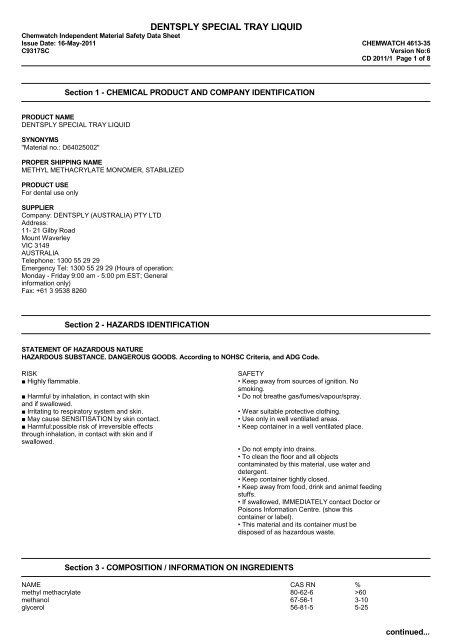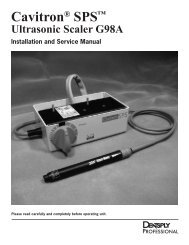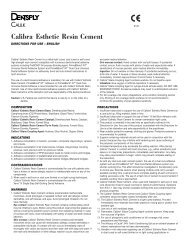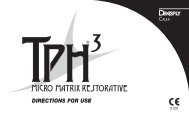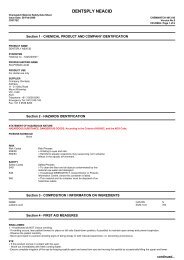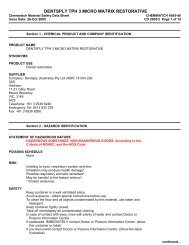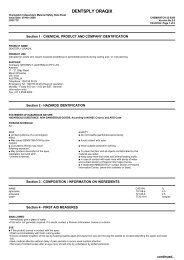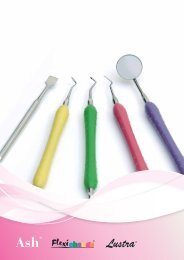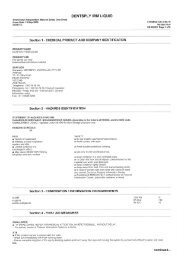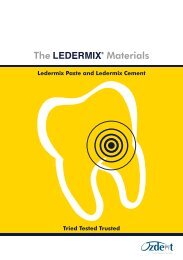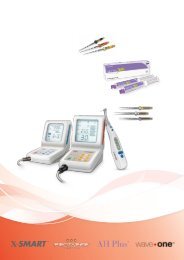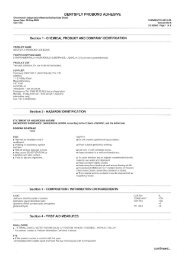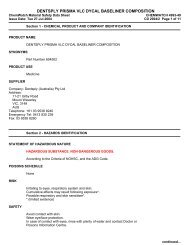Chemwatch Australian MSDS 4613-35 - Dentsply
Chemwatch Australian MSDS 4613-35 - Dentsply
Chemwatch Australian MSDS 4613-35 - Dentsply
You also want an ePaper? Increase the reach of your titles
YUMPU automatically turns print PDFs into web optimized ePapers that Google loves.
DENTSPLY SPECIAL TRAY LIQUID<strong>Chemwatch</strong> Independent Material Safety Data SheetIssue Date: 16-May-2011 CHEMWATCH <strong>4613</strong>-<strong>35</strong>C9317SCVersion No:6CD 2011/1 Page 5 of 8Section 8 - EXPOSURE CONTROLS / PERSONAL PROTECTIONExposure condition Short time use; (few minutesless than 0.5 hour) Little physical stressExposure condition Medium time use; less than 4hours Physical stress (opening drums, usingtools, etc.)Exposure condition Long time CleaningoperationsUse of thin nitrile rubber gloves: Nitrilerubber (0.1 mm) Excellent tactibility (" feel"), powder- free Disposable Inexpensive Giveadequate protection to low molecular weighacrylic monomersUse of medium thick nitrile rubber glovesNitrile rubber, NRL (latex) free; 0.56 mm lowtactibility (" feel" ), powder free High priceGives adequate protection for most acrylates incombination with commonly used solvents up to 8hours Do NOT give adequate protection to lowmolecular weight monomers at exposures longerthan 1 hour Avoid use of ketones and acetatesin wash- up solutions..OTHER• Overalls.• PVC Apron.• PVC protective suit may be required if exposure severe.• Eyewash unit.• Some plastic personal protective equipment (PPE) (e.g. gloves, aprons, overshoes) are not recommended as they may producestatic electricity.• For large scale or continuous use wear tight-weave non-static clothing (no metallic fasteners, cuffs or pockets), non sparkingsafety footwear.ENGINEERING CONTROLS■ For flammable liquids and flammable gases, local exhaust ventilation or a process enclosure ventilation system may be required.Ventilation equipment should be explosion-resistant.Air contaminants generated in the workplace possess varying "escape" velocities which, in turn, determine the "capturevelocities" of fresh circulating air required to effectively remove the contaminant.Type of Contaminant:solvent, vapours, degreasing etc., evaporatingfrom tank (in still air).aerosols, fumes from pouring operations,intermittent container filling, low speedconveyer transfers, welding, spray drift,plating acid fumes, pickling (released at lowvelocity into zone of active generation)direct spray, spray painting in shallow booths,drum filling, conveyer loading, crusher dusts,gas discharge (active generation into zone ofrapid air motion)Air Speed:0.25- 0.5 m/s (50- 100 f/min.)0.5- 1 m/s (100- 200 f/min.)1- 2.5 m/s (200- 500 f/min.).Section 9 - PHYSICAL AND CHEMICAL PROPERTIESAPPEARANCEColourless flammable liquid with an ester-like odour; partly mixes with water.PHYSICAL PROPERTIESLiquid.State Liquid Molecular Weight Not ApplicableMelting Range (°C) - 48.2 (methyl Viscosity 0.63 cSt@20Cmethacrylate)(methylmetacrylate°CBoiling Range (°C) 100.3 (methyl Solubility in water (g/L) P artly Misciblemethacrylate)continued...
DENTSPLY SPECIAL TRAY LIQUID<strong>Chemwatch</strong> Independent Material Safety Data SheetIssue Date: 16-May-2011 CHEMWATCH <strong>4613</strong>-<strong>35</strong>C9317SCVersion No:6CD 2011/1 Page 6 of 8Section 9 - PHYSICAL AND CHEMICAL PROPERTIESFlash Point (°C) 10 (methyl pH (1% solution) Not Applicablemethacrylate)Decomposition Temp (°C) Not Available pH (as supplied) Not A pplicableAutoignition Temp (°C) 430 (methyl Vapour Pressure (kPa) 3. 87methacrylate)Upper Explosive Limit (%) 12.5 (methyl Specific Gravity (water=1) 0.94methacrylate)Lower Explosive Limit (%) 2.1 (methyl Relative Vapour Density Not Availablemethacrylate)(air=1)Volatile Component (%vol) Not Available Evaporation Rate Not Availableglycerollog Kow (Sangster 1997): - 1.76Section 10 - STABILITY AND REACTIVITYCONDITIONS CONTRIBUTING TO INSTABILITY• Stable under controlled storage conditions provided material contains adequate stabiliser / polymerisation inhibitor.• Bulk storages may have special storage requirements• WARNING: Gradual decomposition in strong, sealed containers may lead to a large pressure build-up and subsequent explosion.Rapid and violent polymerisation possible at temperatures above 32 deg c.• Presence of incompatible materials.• Product is considered stable.• Hazardous polymerisation will not occur.For incompatible materials - refer to Section 7 - Handling and Storage.Section 11 - TOXICOLOGICAL INFORMATIONPOTENTIAL HEALTH EFFECTSACUTE HEALTH EFFECTS■ Harmful by inhalation, in contact with skin and ifswallowed.■ Irritating to respiratory system and skin.■ Vapours may cause dizziness or suffocation.CHRONIC HEALTH EFFECTS■ May cause SENSITISATION by skincontact.TOXICITY AND IRRITATION■ Contact allergies quickly manifest themselves as contact eczema, more rarely as urticaria or Quincke's oedema. The pathogenesisof contact eczema involves a cell-mediated (T lymphocytes) immune reaction of the delayed type.Asthma-like symptoms may continue for months or even years after exposure to the material ceases. This may be due to a nonallergeniccondition known as reactive airways dysfunction syndrome (RADS) which can occur following exposure to high levels ofhighly irritating compound.Where no "official" classification for acrylates and methacrylates exists, there has been cautious attempts to createclassifications in the absence of contrary evidence. For exampleMonalkyl or monoarylesters of acrylic acids should be classified as R36/37/38 and R51/53Monoalkyl or monoaryl esters of methacrylic acid should be classified as R36/37/38.The material may cause skin irritation after prolonged or repeated exposure and may produce a contact dermatitis (nonallergic).This form of dermatitis is often characterised by skin redness (erythema) and swelling the epidermis.REPROTOXINmethyl methacrylate ILO Chemicals in the electronics industry Reduced fertility orthat have toxic effects on reproductionsterilitySection 12 - ECOLOGICAL INFORMATIONThis material and its container must be disposed of as hazardous waste.EcotoxicityIngredient Persistence: Persistence: Air Bioaccumulation MobilityWater/Soil<strong>Dentsply</strong> Special Tray Liquid No Data No DataAvailableAvailablecontinued...
DENTSPLY SPECIAL TRAY LIQUID<strong>Chemwatch</strong> Independent Material Safety Data SheetIssue Date: 16-May-2011 CHEMWATCH <strong>4613</strong>-<strong>35</strong>C9317SCVersion No:6CD 2011/1 Page 7 of 8Section 12 - ECOLOGICAL INFORMATIONmethyl methacrylate LOW No Data LOW HIGHAvailablemethanol LOW No Data LOW HIGHAvailableglycerol LOW No Data LOW HIGHAvailableSection 13 - DISPOSAL CONSIDERATIONS• Containers may still present a chemical hazard/ danger when empty.• Return to supplier for reuse/ recycling if possible.Otherwise:• If container can not be cleaned sufficiently well to ensure that residuals do not remain or if the container cannot be used tostore the same product, then puncture containers, to prevent re-use, and bury at an authorised landfill.• Where possible retain label warnings and <strong>MSDS</strong> and observe all notices pertaining to the product.Legislation addressing waste disposal requirements may differ by country, state and/ or territory. Each user must refer to lawsoperating in their area.A Hierarchy of Controls seems to be common - the user should investigate:• Reduction.• DO NOT allow wash water from cleaning or process equipment to enter drains.• It may be necessary to collect all wash water for treatment before disposal.• In all cases disposal to sewer may be subject to local laws and regulations and these should be considered first.• Where in doubt contact the responsible authority.• Recycle wherever possible.• Consult manufacturer for recycling options or consult local or regional waste management authority for disposal if no suitabletreatment or disposal facility can be identified.• Dispose of by: burial in a land-fill specifically licenced to accept chemical and / or pharmaceutical wastes or Incineration ina licenced apparatus (after admixture with suitable combustible material).• Decontaminate empty containers. Observe all label safeguards until containers are cleaned and destroyed.Section 14 - TRANSPORTATION INFORMATIONF L A M M A B L EL I Q U I D3Labels Required: FLAMMABLE LIQUIDHAZCHEM:3YE (ADG7)ADG7:Class or Division: 3 Subsidiary Risk: NoneUN No.: 1247 Packing Group: IISpecial Provision: None Limited Quantity: 1 LPortable Tanks & Bulk T4 Portable Tanks & Bulk TP1Containers -Containers - SpecialInstruction:Provision:Packagings & IBCs - None Packagings & IBCs - P001, IBC02Packing Instruction:Special PackingProvision:Name and Description: METHYL METHACRYLATE MONOMER, STABILIZEDLand Transport UNDG:Class or division: 3 Subsidiary risk: NoneUN No.: 1247 UN packing group: IIShipping Name:METHYL METHACRYLATE MONOMER, STABILIZEDAir Transport IATA:ICAO/IATA Class: 3 ICAO/IATA Subrisk: NoneUN/ID Number: 1247 Packing Group: IISpecial provisions:NoneShipping Name:METHYL METHACRYLATE MONOMER, STABILIZEDcontinued...
DENTSPLY SPECIAL TRAY LIQUID<strong>Chemwatch</strong> Independent Material Safety Data SheetIssue Date: 16-May-2011 CHEMWATCH <strong>4613</strong>-<strong>35</strong>C9317SCVersion No:6CD 2011/1 Page 8 of 8Section 14 - TRANSPORTATION INFORMATIONMaritime Transport IMDG:IMDG Class: 3 IMDG Subrisk: NoneUN Number: 1247 Packing Group: IIEMS Number: F- E , S- D Special provisions: NoneLimited Quantities:1 LShipping Name: METHYL METHACRYLATE MONOMER, STABILIZEDPOISONS SCHEDULE S5REGULATIONSRegulations for ingredientsSection 15 - REGULATORY INFORMATIONmethyl methacrylate (CAS: 80-62-6) is found on the following regulatory lists;"Australia Dangerous Goods Code (ADG Code) - Goods Too Dangerous To Be Transported","Australia Exposure Standards","AustraliaHazardous Substances","Australia High Volume Industrial Chemical List (HVICL)","Australia National Pollutant Inventory","Australia Standard for the Uniform Scheduling of Medicines and Poisons (SUSMP) - Appendix C","Australia Standard for the UniformScheduling of Medicines and Poisons (SUSMP) - Appendix F (Part 3)","Australia Standard for the Uniform Scheduling of Medicinesand Poisons (SUSMP) - Schedule 6","GESAMP/EHS Composite List - GESAMP Hazard Profiles","IMO IBC Code Chapter 17: Summary ofminimum requirements","IMO MARPOL 73/78 (Annex II) - List of Noxious Liquid Substances Carried in Bulk","International AirTransport Association (IATA) Dangerous Goods Regulations","International Air Transport Association (IATA) Dangerous GoodsRegulations - Prohibited List","OECD Representative List of High Production Volume (HPV) Chemicals"methanol (CAS: 67-56-1) is found on the following regulatory lists;"Australia - New South Wales Hazardous Substances Prohibited for Specific Uses","Australia Exposure Standards","AustraliaHazardous Substances","Australia High Volume Industrial Chemical List (HVICL)","Australia National Pollutant Inventory","Australia Standard for the Uniform Scheduling of Medicines and Poisons (SUSMP) - Appendix E (Part 2)","Australia Standard forthe Uniform Scheduling of Medicines and Poisons (SUSMP) - Appendix F (Part 3)","Australia Standard for the Uniform Scheduling ofMedicines and Poisons (SUSMP) - Schedule 5","Australia Standard for the Uniform Scheduling of Medicines and Poisons (SUSMP) -Schedule 6","GESAMP/EHS Composite List - GESAMP Hazard Profiles","IMO IBC Code Chapter 17: Summary of minimum requirements","IMOMARPOL 73/78 (Annex II) - List of Other Liquid Substances","International Council of Chemical Associations (ICCA) - HighProduction Volume List","OECD Representative List of High Production Volume (HPV) Chemicals"glycerol (CAS: 56-81-5) is found on the following regulatory lists;"Australia Exposure Standards","Australia High Volume Industrial Chemical List (HVICL)","Australia Therapeutic GoodsAdministration (TGA) Substances that may be used as active ingredients in Listed medicines","CODEX General Standard for FoodAdditives (GSFA) - Additives Permitted for Use in Food in General, Unless Otherwise Specified, in Accordance with GMP","GESAMP/EHS Composite List - GESAMP Hazard Profiles","IMO IBC Code Chapter 18: List of products to which the Code does not apply","IMO MARPOL 73/78 (Annex II) - List of Other Liquid Substances","International Council of Chemical Associations (ICCA) - HighProduction Volume List","International Fragrance Association (IFRA) Survey: Transparency List","OECD Representative List of HighProduction Volume (HPV) Chemicals"No data for <strong>Dentsply</strong> Special Tray Liquid (CW: <strong>4613</strong>-<strong>35</strong>)Section 16 - OTHER INFORMATION■ Classification of the preparation and its individual components has drawn on official and authoritative sources as well asindependent review by the <strong>Chemwatch</strong> Classification committee using available literature references.A list of reference resources used to assist the committee may be found at:www.chemwatch.net/references.■ The (M)SDS is a Hazard Communication tool and should be used to assist in the Risk Assessment. Many factors determine whetherthe reported Hazards are Risks in the workplace or other settings.This document is copyright. Apart from any fair dealing for the purposes of private study, research, review orcriticism, as permitted under the Copyright Act, no part may be reproduced by any process without writtenpermission from CHEMWATCH. TEL (+61 3) 9572 4700.Issue Date: 16-May-2011Print Date: 16-May-2011This is the end of the <strong>MSDS</strong>.


